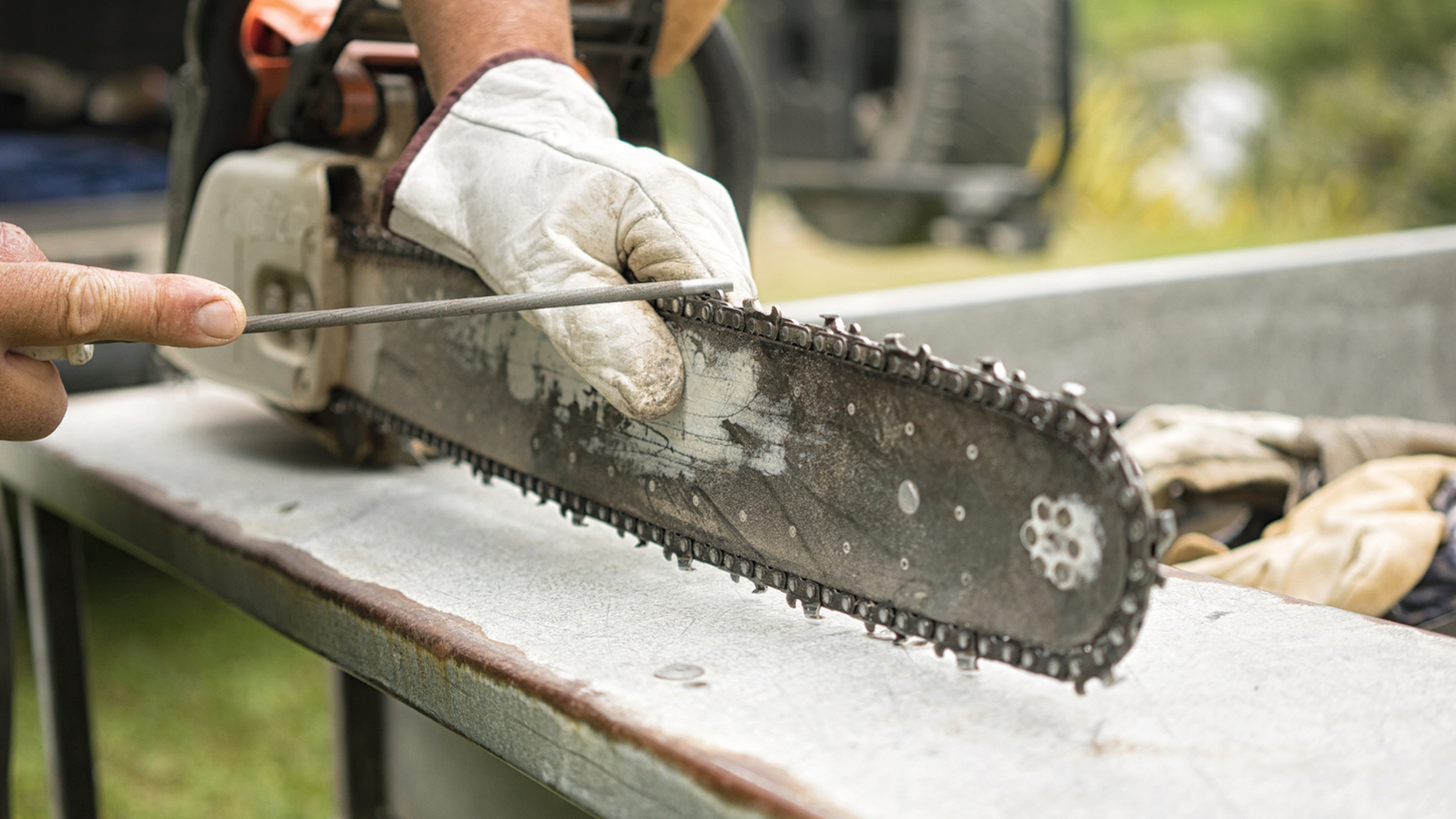
Round file
Flat file
Clamp
Pen
Looking to keep your device in top condition? Learning how to sharpen a chainsaw blade with a file is a great place to start. Nothing beats a chainsaw when it comes to powerful performance, but you must maintain it to continue reaping the benefits.
So why bother sharpening your chainsaw? If you fail to keep up with this task, the blades will become dull, making cutting difficult. Surprisingly, dull blades increase the chance of an injury - you must exert more pressure and sacrifice control.
We’ve consulted an expert about how to sharpen a chainsaw blade with a file. You’ll learn step by step to master the art of filing a chainsaw.
Using a file is an affordable way to sharpen your chainsaw from the comfort of your home (or shed), compared to taking your device to a pro.
If your chainsaw is beyond repair, read our round-up of the best chainsaws when selecting a replacement.
How to sharpen a chainsaw: step-by-step guide
1. Select your tools
“There are many different files available specifically made for sharpening chainsaws. They're affordable and easy to use,” says Melody Estes, Landscape Gardening Supervisor from Maine and a consultant at The Project Girl. Check your manual for the recommended size. Equip yourself with a round file for the teeth and a flat file for the rakers.
2. Prepare your chainsaw
Clamp your chainsaw to the surface to steady it. Tighten the chain. Mark the first tooth with a pen to know when you’ve reached it again.
3. Sharpen the teeth
Your chainsaw has two types of cutters: forward-facing and backward-facing ones. File all of one type and then the other.
“You need to file in a way that doesn't damage the chain,” says Melody. Pay attention to the angle. It’s usually approximately 25 degrees, though, according to your manual. For maximum accuracy, invest in a file guide.
Slide the file across each tooth about 5 times in a forward motion. Count the times you sharpen each cutter to achieve a consistent finish.
4. Sharpen the rakers
Next, examine the gap between the teeth and the rakers (the bumps between them). Use a depth gauge to determine whether any of the rakers are protruding. Slide a flat-file across these to maintain the correct alignment.

How to sharpen a chainsaw: Troubleshooting
Want to know one of the top chainsaw sharpening mistakes? New chainsaw owners often use the wrong tools for the job. Rick Jason Martineau, Senior Training Specialist for Tree Professional Products at Husqvarna, explains it’s vital to “use the correct file type and size.” Chainsaws come in all shapes and sizes, and as you might expect, a chainsaw with a larger chain will need a larger file. Check your manual if you’re not sure.
Next, you’ll want to master the correct technique for filing. “The file is only effective in one direction, forward stroke,” explains Rick. You may be tempted to save time by moving the file forward and back, but it’s a no-no. This movement can dull the chain and damage your file, so reset it each time. Count the number of times you file each tooth for maximum precision and keep it consistent for an even finish.
The angle is another important factor. “The straighter you can keep the file along the cutting edge, the better. The top edge of the tooth should not appear curved when you finish,” adds Rick. If you’re a beginner, investing in a file guide can help you get the right angle while you hone your technique.
How to sharpen a chainsaw: FAQs
How many strokes does it take to sharpen a chainsaw?
Each tooth on a chainsaw chain needs to be sharpened individually, so a common guideline is to use a file or sharpening tool three to five times per tooth. A chainsaw chain with 30 teeth would mean 90 to 150 strokes. The exact number depends on the sharpness needed and the chain's wear. However, that's just a rough estimate.
A chain that's just a little dull might only need a few strokes to sharpen, but if it's very worn out or damaged, it might need more strokes. A professional sharpener can sometimes save you a lot of time and effort since it gives you a more uniform edge with fewer strokes.
Keep a consistent angle while sharpening. Most chains are designed to be sharpened at a specific angle, usually 25 to 30 degrees. If you keep this angle consistent, you'll sharpen more efficiently, reducing the number of strokes you need.
Do you push or pull when sharpening a chainsaw?
Most chainsaw sharpening files are designed to be used by pulling the file towards you. This allows for greater control and precision since it aligns the file with the tooth cutting edge. For effective sharpening, you must maintain the right angle, typically around 25 to 30 degrees, when you pull the file. By pulling the file, you don't damage the tooth since you don't have to worry about it slipping off.
However, pushing the file away can sometimes make sharpening less effective. It can cause the file to skip or drag unevenly across the tooth, resulting in a rough edge. Some people find that a combination of push and pull strokes works best if you're using a guide or sharpening tool.
If you sharpen, make sure you apply even pressure throughout the stroke. A constant number of strokes on each tooth will ensure uniform sharpness across the chain. Too much force can damage the file or the chain, while too little may not sharpen effectively. Consistency is key.
Do you sharpen both sides of chainsaw chain?
When you sharpen only one side of the chain without the other, the chainsaw will pull to one side during cutting. This not only affects the precision of your cuts but can also increase the risk of kickback, making the chainsaw more difficult to control and potentially dangerous.
If you're sharpening, you'll usually start with one side, sharpening each tooth according to the manufacturer's specs, usually at about 25 to 30 degrees. It's important to flip the chainsaw chain after you've sharpened one side. This makes sure all the teeth are sharpened evenly, resulting in a balanced cutting experience.
The rakers, or depth gauges, control how deep the teeth cut into the wood. If the rakers are too high, they can stop the chain from cutting efficiently, even if the teeth are sharp.







